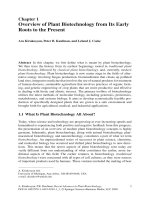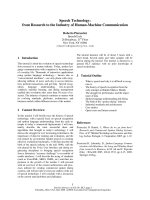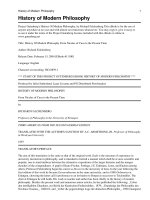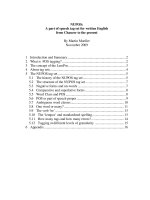From windfall to curse oil and industrialization in venezuela, 1920 to the present
Bạn đang xem bản rút gọn của tài liệu. Xem và tải ngay bản đầy đủ của tài liệu tại đây (4.21 MB, 362 trang )
Jonathan Di John
from
Windfall
Curse?
to
oil and industrialization in venezuela ,
1920 to the present
00front.qxd
9/9/2009
9:08 AM
Page i
from Windfall to Curse?
00front.qxd
9/9/2009
9:08 AM
Page ii
.......
.......
00front.qxd
9/9/2009
9:08 AM
Page iii
Jonathan Di John
from
Windfall
Curse?
......................................................................................................................................................................................................................................
to
......................................................................................................................................................................................................................................
oil and industrialization in venezuela,
1920 to the present
the pennsylvania state university press
university park, pennsylvania
00front.qxd
9/21/09
2:18 PM
Page iv
Library of Congress Cataloging-in-Publication Data
DiJohn, Jonathan.
From windfall to curse? : oil and industrialization in Venezuela,
to the present / Jonathan Di John.
p.
cm.
Includes bibliographical references and index.
Summary: “Examines the political economy of growth in Venezuela
since the discovery of oil in ”—Provided by publisher.
---- (cloth : alk. paper)
. Venezuela—Economic conditions—–.
. Venezuela—Economic conditions—–.
. Venezuela—Economic policy.
. Petroleum industry and trade—Venezuela.
. Industrialization—Venezuela.
I. Title.
.
.´—dc
Copyright © The Pennsylvania State University
All rights reserved
Printed in the United States of America
Published by The Pennsylvania State University Press,
University Park, PA -
The Pennsylvania State University Press is a member of
the Association of American University Presses.
It is the policy of The Pennsylvania State University Press
to use acid-free paper. Publications on uncoated stock
satisfy the minimum requirements of American National
Standard for Information Sciences—Permanence of
Paper for Printed Library Material, .–.
This book is printed on Natures Natural, which contains %
post-consumer waste.
00front.qxd
9/9/2009
9:08 AM
Page v
contents
...........................................................................................
Preface and Acknowledgments vii
List of Abbreviations xv
part one: introduction
1 Accounting for Growth and Decline in Venezuela 3
2 Trends and Cycles in the Venezuelan Economy 15
part two: a critical survey of the “resource curse” literature
3 Economic Explanations of the Growth Collapse in Venezuela 35
4 Political Economy Explanations of the Growth Collapse in
Venezuela 77
5 Economic Liberalization, Political Instability, and State Capacity in
Venezuela 108
part three: an alternative political economy of venezuelan
growth and decline
6
7
8
9
Toward a New Political Economy of Late Industrialization 133
Periodization of Industrialization Stages and Strategies in Venezuela 169
The Structure of and Changes in Political Settlements in Venezuela 186
A New View on the Political Economy of Growth in Venezuela 226
part four: beyond the venezuelan case
10 The Political Economy of Growth in Malaysia and Venezuela 271
11 Conclusion: Rethinking the Political Economy of Growth 285
References 303
Index 327
00front.qxd
9/9/2009
9:08 AM
Page vi
...
00front.qxd
9/9/2009
9:08 AM
Page vii
preface and acknowledgments
...........................................................................................
Understanding why the wealth of less developed nations increases over time is
one of the oldest concerns of political economy and development economics.
Reigning theories of economic growth postulate that there are linear tendencies in the growth process. Depending on the assumptions, growth theories
predict either divergence or convergence of the income per capita of less developed counties trying to catch up with advanced industrial countries. Reality
paints a different picture of the growth process. The fastest-growing countries
are never the countries with the highest per capita incomes, but always a small
subset of lower-income countries. Economic theories of growth are thus of
limited use in explaining the wide and persistent divergence of performance
among late developing countries. Furthermore, growth theories cannot explain
why some countries sustain rapid growth for long periods only to fade into
long periods of stagnation and even downward spiral and disintegration. A
major challenge of political economy is to explain why economic growth varies
so widely within countries over time.
The Venezuelan experience since the discovery of oil in the 1920s provides
one such interesting example. Venezuela was among the fastest-growing economies in Latin America in the period 1920–80. However, two important trends
mark the period 1968–2005. First, from the mid-1960s the non-oil economy,
and particularly the manufacturing sector, experienced a dramatic decline in
non-oil and manufacturing productivity growth. Second, output growth in the
manufacturing sector (and the non-oil economy more generally) collapsed in
the period 1980–2003. Accompanying this decline was the virtual collapse of
once vibrant political parties and the rise of a more volatile and unstable form
of antiparty politics and governance in the first decade of the 2000s.
More perplexing is the fact that worsening economic performance coincided with many favorable initial conditions such as high levels of human and
physical capital investment, a competitive democratic system since 1958, and
plentiful resources to finance growth. Was this worsening economic performance due to policy errors or inappropriate institutions, or did oil windfalls
themselves become a “curse” by crowding out the development of non-oil sectors such as manufacturing, or were there other factors that explain the slowdown in growth? This book attempts to answer these questions.
00front.qxd
9/9/2009
9:08 AM
Page viii
viii ..........................................................................Preface and Acknowledgments
Explaining what factors contribute to growth (such as high levels of investment, secure property rights, macroeconomic stability) does not tell us how or
why such factors are achieved. This is where role of the state becomes relevant,
since the state is the set of institutions that is responsible for the creating and
implementing the regulatory structure of the economy, which determines the incentives of economic actors. One of the oldest (and most ideologically charged)
debates in the political economy of development is identifying what types of
state intervention are most likely to promote sustained economic growth.
Advocates of laissez-faire suggest that state intervention distorts markets,
stifles competition, and generates corruption, all of which create obstacles to
potentially growth-enhancing investments. In recent times, this view has dominated as manifested in the adoption of widespread economic liberalization,
particularly within Latin America. The outcome of such reforms in Venezuela
as well as in most of the region, however, has been disappointing. Economic
liberalization has failed to revive investment and growth to the levels of 1950s
and 1960s, when more interventionist policies were followed. While the state in
Venezuela and many other less developed economies have failed to generate
and implement growth-enhancing regulatory structures, market liberalization
does not eliminate the market failures and risks of late development that justified state intervention in the first place. The failure of economic liberalization
to deliver positive developmental outcomes is not confined to the world of less
developed countries. For instance, advocates of laissez-faire saw little need to
regulate financial markets because it was thought that market competition
would weed out poorly performing investments and thus generate socially
productive resource allocation. The world financial and economic crises that
emerged in 2008 suggest that such confidence in lightly regulated financial
markets was unfounded.
In contrast, developmental state theorists have pointed to the benefits that
state intervention, and particularly industrial policy, can have in promoting
learning and technology acquisition, and in socializing the risks infant industries face in the context of trying to catch up with more experienced and
productive firms in advanced industrial countries. Advocates of more dirigiste
strategies will point to the effectiveness of various types of industrial strategies
in East Asia. And indeed, the Venezuelan state attempted to implement stateled industrial policy from the late 1950s. While the potential benefits of state
intervention may be accepted, developmental state theorists do not explain
why most countries that tried policies similar to those of more successful
industrial policy states have been far less successful.
00front.qxd
9/9/2009
9:08 AM
Page ix
Preface and Acknowledgments............................................................................ix
The historical evidence suggests that there are a variety of models of state
intervention that can promote economic development. The broader question
is why leaders in economies undergoing economic decline do not alter the regulatory structure that approximates one of the various production strategies
that could enhance growth. The analytical narrative of the Venezuelan growth
process since the 1920s presented in this book also attempts to answer this
broad question.
Part One summarizes the main argument and introduces the main economic
trends in the Venezuelan economy. Part Two provides an extensive critical
examination of arguments have dominated discourse on Venezuela’s long-run
economic decline in the post-1968 period. The most important is the so-called
resource curse, which is the idea that oil abundance harms the prospects of
economic growth. There is a vast “resource curse” literature in economics,
political science, and political economy which attempts to explain the negative
effects oil windfalls and busts can have on the structure of the economy and on
patterns of governance.
The main problem with these arguments is that they cannot explain why
oil abundance has been compatible with cycles of growth and stagnation in
Venezuela over the period 1920–2005. Comparative evidence presented in this
book suggests that Venezuela has not been an “exceptional” case in Latin America. Problems of growth slowdown, external debt, and capital flight (which featured in post-1980 Venezuela) were a feature of most countries in the region.
This suggests that understanding Venezuela’s growth trajectory may have resonance for other middle-income Latin American and oil-abundant economies
in other regions.
Part Three offers a new explanation of the long-run cycles of growth and
decline that Venezuela has experienced since 1920. It argues that reigning explanations of Venezuela’s growth slowdown (as well as the more general literature
on state intervention whether from a neoliberal or developmental state perspective) do not examine the extent to which different development strategies
and stages of import-substitution affect the economic and political challenges
and conflicts that state policymakers face in attempting to implement industrial policies. Detailed historical evidence presented in Part Three suggests that
the process of industrialization involved two very different strategies over
time. The period from the early 1900s to the late 1960s was a period of “easy”
import-substitution strategies, where infant industry production tends to be
technologically simple and small-scale and where require major coordination
of investment by the state is not essential for rapid growth to occur. Moreover,
00front.qxd
9/9/2009
9:08 AM
Page x
x..............................................................................Preface and Acknowledgments
export growth was not central to the prospects of sustained capital accumulation under this strategy.
The period 1960–73 is characterized by a switch in the development strategy that emphasized more advanced import-substituting industrialization
(isi) in intermediate goods and heavy industry, and in particular a “big push”
in natural-resource-based industries in oil refining, steel, aluminum, chemicals, and hydroelectric power. This more advanced isi strategy dominated the
state-led industrial development strategy from the early 1970s on. What distinguishes the advanced isi/big-push strategy from the “easy isi” strategies is that
infant industrial production tends to be more technologically demanding, largescale, and longer-gestating and tends to require major coordination of largescale investments by the state and private sector for effective implementation.
A main contribution of this book is to demonstrate how and why this
distinction between these two types of development strategy matters for
understanding the growth trajectory of the Venezuelan economy. In early isi
strategies, state-led industrial policy is not very demanding in either economic
or political terms. Because scale economies were generally small, and exporting not decisive to firm development at the early stage of isi, the state was not
compelled to be selective in the distribution of protection and subsidies, nor
was it necessary that state be able to discipline the recipients of subsidies.
In contrast to the early isi strategies, it is shown that the capacity of the state
to coordinate industrial investment, to be selective in the subsidy process, and
to discipline the recipients of subsidies becomes relevant for the effective
implementation of more advanced isi/big push industrialization strategies.
This is because scale economies are more central to the development of competitive firms, and because many of the investments are interdependent.
More advanced isi strategies require a polity that is capable of coordinating
investments and effectively monitoring the deployment of subsidies to infant
industries. This in turn means that large-scale fragmentation of political organizations and the state and major disagreements over policy among contending political parties, factions of capital, and labor unions are likely to negatively
affect productivity and output growth, particularly in the manufacturing sector. Given the contingent nature of political institutions and contests, there is
no reason to expect that the appropriate institutional structure and politics
will emerge to accommodate a country’s stage of development and changing technological challenges. The mapping of political strategies and types of
development trajectory followed opens up the possibility of explaining growth
accelerations as the result of the compatibility between development strategy
00front.qxd
9/9/2009
9:08 AM
Page xi
Preface and Acknowledgments............................................................................xi
and political settlements and, analogously, growth slowdowns as the result of a
growing incompatibility, or mismatch between political settlements and development strategies.
The final chapter of Part Three maps the evolution of development strategies and political settlements in the period 1920–2005. In the course of this
mapping exercise (which is based on detailed historical, economic, and political
literature on Venezuela), it is demonstrated how and why growth was achieved
as a result of a broad compatibility between the development strategy and the
organization of political competition in the period 1920–68, and how and why
output and productivity growth stagnated and eventually collapsed as a result
of a growing incompatibility between the development strategy and organization of political competition in the period 1968–2005. It is argued that theories
of the “resource curse,” as well as more general theories of state intervention
(whether of the neoliberal or developmental state variety), will be better able
to explain variations and changes in growth within and across less developed
economies by incorporating historically specific politics (especially the structure of political organizations and the shifting grounds of legitimate rule)
and production (stage of development and development strategy) in a more
interactive way than is generally undertaken. The arguments in this book also
suggest that an understanding of the variation and change in growth across
and within mineral-abundant less developed economies needs fundamental
rethinking that moves beyond the simplistic notions of “windfall” and “curse.”
There are many who have provided invaluable support and guidance through
the often lonely and dark wood of a long-term research project. I would first
of all like to thank Gabriel Palma, who taught me many lessons (during my
doctoral studies at the University of Cambridge) on the economic and political history of Latin America that formed the basis of much of my thinking on
Venezuela. His critical analysis of my work made correcting earlier versions of
this book a rewarding experience. His unending encouragement and friendship have been and continue to be an invaluable source of inspiration.
I am indebted to many of my colleagues and friends who have inspired and
helped me to think through difficult concepts and ideas. In particular, I want
to thank Christopher Cramer, Jonathan Pincus, Dennis Rodgers, and Ha-Joon
Chang for invaluable support. John Sender was one of the best mentors an
aspiring development economist could have. He really changed the way I
viewed development processes and inspired me, as a master’s student in Cambridge, to explore the difficult terrain of political economy. His insistence on
00front.qxd
9/9/2009
9:08 AM
Page xii
xii ...........................................................................Preface and Acknowledgments
the importance of critical thinking and the marshaling of supporting evidence
has remained with me. I especially want to thank Mushtaq Khan, who has not
only been a close friend, but whose thinking and scholarship on the political
economy of institutions have profoundly influenced my ideas. James Putzel, a
colleague during my six years as a lecturer at the London School of Economics
and still a close and dear friend, read many earlier versions of this work, and
his constructive critical eye helped me greatly. James instilled in me the importance of examining history and politics, but his incalculable support, encouragement, and intellectual stimulation provided me with the confidence to find
my way out of the dark wood. Finally, I want to thank Peter Nolan and John
Weeks, who both read earlier versions of this manuscript and provided valuable comments.
Many thanks to the Crisis States Research Center at the London School of
Economics for providing research funding, which permitted me to gather information on the post-1998 period, especially relevant for Chapters 7 and 8.
There are many who made my eight-year residence in Venezuela a rewarding
experience both intellectually and personally. Dr. Jaime Torres helped orient
me to the country and provided valuable guidance and friendship throughout
my first years. This project would never have seen the light of day without the
many academics and friends at the Instituto Superiores de Administración
(iesa) in Caracas, who provided me with valuable guidance and contacts that
helped me explore the magic realism of the Venezuelan political system and
economy. Ricardo Hausmann, whom I first met in England, provided the first
encouragement for me to study Venezuela and helped me get settled at iesa.
His wit, intellect, and passion for economic development are contagious. I also
want to thank Asdrúbal Baptista, Gustavo Garcia, Rosa Amelia González, José
Malavé, Gustavo Márquez, Ramón Piñango, and the late Janet Kelly for all their
help. I particularly am indebted to Carmen Portela, who always believed that
my exploration of Venezuelan economic history was worthwhile and who provided support and friendship throughout my time in Venezuela and with whom
I share a wonderful bond through our daughter, Iria.
I also would like to thank Francisco Rodríguez, who shared his impressive
command of economic theory and historical knowledge of Venezuela, and
who provided very insightful comments on earlier drafts. I would equally like
to thank Javier Corrales, who also read earlier drafts and offered very useful
comments, particularly on the evolution of the Venezuelan political system.
I am also grateful to several people to those who agreed to extensive interviews that contributed substantially to my knowledge of important economic
00front.qxd
9/9/2009
9:08 AM
Page xiii
Preface and Acknowledgments .........................................................................xiii
and political trends in Venezuela. I would especially like to thank Alberto
Cudemus, José Giacopinni Zárraga, Marcel Granier, Margarita López Maya,
Tibisay Lucena, Osmel Manzano, Michael Penfold, Luis Lander, Gumersindo
Rodríguez, and Miguel Rodríguez.
My wife, Anne, has been a constant inspiration. Her gentle grace and unconditional support made me see the light in the dark wood, and I am forever
grateful. The completion of this work has coincided with the arrival of our
daughter, Sophia, who has provided both joy and inspiration in the final editing of the manuscript.
I owe the deepest gratitude to my brother David and my sister Joanne for all
their moral support and friendship. I am most indebted to my parents, Rose
and John, who have never given up on me and whose affections and support
always enabled me to restore my tranquillity, belief, and perseverance. I dedicate this work to them.
00front.qxd
9/9/2009
9:08 AM
Page xiv
...
00front.qxd
9/9/2009
9:08 AM
Page xv
abbreviations
...........................................................................................
ad
Acción Democrática (Venezuelan Social-Democratic Party)
alcasa
Aluminio del Caroní (state aluminum company)
bauxiven
Bauxita de Venezuela (state bauxite company)
bcv
Banco Central de Venezuela (Central Bank of Venezuela)
cantv
Compañía Anónima Nacional Teléfonos de Venezuela (state
telephone company)
cendes
Centro de Estudios del Desarrollo
cepr
Center for Economic and Policy Research
cne
Consejo Nacional Electoral (National Electoral
Commission)
copei
Comité de Organización Política Electoral Independiente
(Christian Democratic Party)
copre
Comisión Presidencial para la Reforma del Estado
(Presidential Commission on State Reform)
cordiplan
Oficina Central de Coordinación y Planificación de la
Presidencia de la Repúbica (Central Office for Coordination
and Planning)
criap
Comisión para el Estudio de la Reforma Integral de la
Administración Pública (Public Administration Reform
Commission)
ctv
Condeferación de Trabajadores de Venezuela (Confederation
of Venezuelan Workers)
cvg
Corporación Venezolana de Guyana (Venezuelan Guyana
Corporation, state holding company)
eclac
Economic Commission of Latin America and the Caribbean
fedecameras Federación Venezolana de Cámeras y Asociaciones de
Comercio y Producción (main Venezuelan business
chamber)
00front.qxd
9/9/2009
9:08 AM
Page xvi
xvi ...................................................................................................Abbreviations
finexpo
Fondo de Exportaciones (Venezuelan state export credit
fund)
fiv
Fondo de Inversiones de Venezuela (Venezuelan investment
fund)
gdp
gross domestic product
iadb
Inter-American Development Bank
icor
incremental capital output ratio
iesa
Instituto Superiores de Administración (leading Venezuelan
business school)
imf
International Monetary Fund
ine
Instituto Nacional de Estadística (Venezuelan national
statistics office)
intevep
Instituto de Tecnología Venezolana para el Petróleo
(Venezuelan Petroleum Technology Institute)
ipc
International Poverty Centre
isi
import-substituting industrialization
isic
international standard industrial classification
ldc
less developed country
lospp
Ley Orgánica de Salvaguardia del Patriminio Público
(Venezuelan state property protection law)
mbr-200
Movimiento Bolivariano Revolucionario-200 (Bolivarian
Revolutionary Movement 200)
mvr
Movimiento Quinta República (Fifth Republic Movement)
nber
National Bureau of Economic Research
nep
New Economic Policy (Malaysian state development plan)
nic
newly industrializing country
nrbi
natural resource-based industrialization
ocei
Oficina Central de Estadística e Informática (Central Office
of Statistics and Information)
ocepre
Oficina Central del Presupuesto (National Budget Office)
oecd
Organization for Economic Cooperation and Development
00front.qxd
9/9/2009
9:08 AM
Page xvii
Abbreviations .................................................................................................xvii
opec
Organisation of Petroleum Exporting Countries
pdvsa
Petróleos de Venezuela (state oil company)
pe
public enterprise
pequiven
Petroquímica de Venezuela (state petrochemical company)
posco
Pohang Iron and Steel Company, Ltd. (South Korean state
steel company)
pp
Patriotic Pole (alliance of political parties supporting Hugo
Chávez)
psuv
Partido Socialista Unida de Venezuela (United Socialist Party
of Venezuela)
recadi
Régimen de Cambios Diferenciales (Preferential Exchange
Regime)
sidor
Siderúrgica de Orinoco, S.A. (state steel company)
soe
state-owned enterprise
tfp
total factor productivity
umno
United Malays National Organization
unctad
United Nations Committee on Trade and Development
undp
United Nations Development Programme
unesco
United Nations Educational, Scientific, and Cultural
Organization
unido
United Nations Industrial Development Organization
urd
Unión Republicana Democrática (Democratic Republican
Union party)
venalum
Industrias Venezolanas de Alumunio (state aluminum
company)
wider
World Institute for Development Economics Research
wto
World Trade Organization
00front.qxd
9/9/2009
9:08 AM
Page xviii
01chap1.qxd
9/9/2009
9:08 AM
Page 1
part 1
................................................
introduction
01chap1.qxd
9/9/2009
9:08 AM
Page 2
..
01chap1.qxd
9/9/2009
9:08 AM
Page 3
1
...........................................................
accounting for growth and decline in venezuela
This work examines the political economy of industrial policy and economic
growth in Venezuela in the period 1920–2005. Soon after the discovery of oil
in Venezuela during the 1920s, the idea of “sowing the oil,” that is, diversifying
the production and export structure, was an important organizing concept
among economic and political elites (Baptista and Mommer 1987). Since the
early 1950s, the industrialization process became increasingly state led. The role
of the state was marked by a purposeful policy of import substitution that
coincided with the transition to democracy in 1958. Moreover, political leaders
set Venezuela on a path of a more pronounced state-led, “big-push” naturalresource-based heavy industrialization that focused on the development of
state-owned enterprises in steel, aluminum, petrochemicals, oil refining, and
hydroelectric power. The Venezuelan state-led, big-push heavy industrialization strategy was not dissimilar in intent, ambition, and scope from state-led
industrialization strategies in South Korea, Taiwan, Malaysia, and Brazil, as well
as some other oil-exporting developing economies.
Venezuela’s growth trends have, however, several distinguishing and perplexing characteristics. On the one hand, Venezuela was among the fastestgrowing economies in Latin America from 1920 to 1965, and its manufacturing
growth rate was among the most rapid until the mid-1970s. However, from the
mid-1960s the non-oil economy, and particularly the manufacturing sector,
experienced a dramatic decline in total factor productivity growth and labor
productivity growth. Then, output growth in the manufacturing sector (and
the non-oil economy more generally) collapsed in the period 1980–2003. The
01chap1.qxd
9/9/2009
9:08 AM
Page 4
4 .......................................................................................................Introduction
only factor that kept growth rates afloat in the 1970s was the reflationary impact of high government spending as a result of two oil booms. Even so, after
1980 Venezuela’s growth was among lowest of all late-developing economies.
A profound political crisis accompanied this decline. From the early 1990s
to 2005, the Venezuelan polity was characterized by deteriorating political
order, growing instability, and legitimacy crises, characterized by increasingly
frequent coup attempts, alarming increases in voter absenteeism, the growing
use of corruption scandals as instruments of political competition, and the virtual disappearance of the traditional political parties that were central to a
country that was once considered a model of democratic stability. In contrast
to the literature that studies crises in authoritarian rule (e.g., Malloy 1977), or
in transitions to democracy (e.g., Przeworski 1991), this book examines the tensions and processes of late development within a long-standing democracy.
Such dramatic changes in long-run growth rates are not well understood
in mainstream economic theory. This is because growth theory is concerned
with linear trajectories among late-developing economies. “Old” neoclassical
growth theories (Solow 1956) predicted convergence in income levels across
countries, arguing that given the potentially greater returns to capital in less
developed areas, late developers would “catch up.” “New” theories of endogenous growth (Romer 1986; Lucas 1988) argue that because investments generate greater externalities in the context of larger stocks of human and physical
capital, divergence in income levels across the world will persist or even grow.
However, neither the old nor the new growth theories predict the actually
observed relationship that the fastest-growing countries are never the countries with the highest per capita incomes, but always a subset of lower-income
countries (Olson [1996] 2000, 57). Thus, economic theories of growth are of
limited use in explaining the wide and persistent divergence of performance
among late-developing countries. Indeed, neoclassical growth theories, on their
own, cannot explain why some countries sustain rapid growth for long periods
only to fade into long periods of stagnation and even downward spiral and
disintegration.
The dramatic slowdown in growth was paradoxical, since Venezuela seemed
to be a likely candidate to maintain its rapid growth. First, in the period 1974–
85, Venezuela received an enormous increase in resource availability as a result
of oil windfalls. Second, Venezuela maintained relatively high levels of physical
and human capital investment in the context of a relatively accountable longstanding democratic polity. The dominant literature on governance and institutions asserts that greater democratic competition is central to checking the
01chap1.qxd
9/9/2009
9:08 AM
Page 5
Accounting for Growth and Decline in Venezuela...................................................5
potentially ineffective use of discretion and authority by state leaders, thus
assuring effective governance (North 1990; Olson 1993; World Bank 1997a; Sen
1999). Third, the Venezuelan state has not had to contend with ethnic, regional,
caste, or religious conflicts, which make governance and the maintenance of
social order particularly difficult in many parts of the developing world, including such long-standing democracies as India and Sri Lanka (Clague et al.
1997). In the Latin American context, Venezuela also maintained among the
least inequitable distributions of income. In sum, Venezuela appeared to possess many favorable “initial conditions” and “social capabilities” (Abramowitz
1986) for rapid catch-up.
Despite massive resource availability in the 1970s and 1980s, the state became
increasingly ineffective in channeling oil revenues in productivity-enhancing
and growth-enhancing ways. The failure of the state and other actors within
the economy to provide policies and institutions to maintain historically high
growth rates, especially in comparison with other similarly endowed middleincome economies, such as Malaysia or South Korea, who were following similar types of industrial policies, is therefore interesting in providing insights
into the political economy of growth in Venezuela. Was the failure due to policy errors or inappropriate institutions, or did oil windfalls themselves become
a “curse” by crowding out the development of non-oil sectors such as manufacturing, or were there other factors that explain the slowdown in growth?
The structure of the book is as follows. Chapter 2 examines the main trends
in output growth, productivity growth, and investment in the non-oil sector in
general, and the manufacturing sector in particular. There are two main points
that emerge from the long-run growth trends in Venezuela. The first is that
worsening economic performance since 1968 cannot be attributed to poor “initial conditions.” Indeed, I demonstrate that the growth slowdown and later
implosion coincided with historically and comparatively high levels of physical and human capital investment in the context of a political economy with
relatively equal income distribution and a competitive democratic system. The
second main trend uncovered is the reversal in the efficiency of the economy in
managing oil abundance. This is done through simple statistical analysis. The
period 1920–65 is characterized by a positive correlation of non-oil growth and
real oil prices, while the subsequent period 1965–98 is characterized by a significantly negative relationship between these two variables. This underlying
pattern suggests a decline in the efficiency of the fiscal linkage in Venezuela and
forms an important organizing trend from which to test competing theories
about economic growth and industrial policy in twentieth-century Venezuela.
01chap1.qxd
9/9/2009
9:08 AM
Page 6
6 .......................................................................................................Introduction
Part Two (Chapters 3–5) critically examines the reigning explanations of the
output and productivity growth slowdown in the post-1968 period. Chapters 3
and 4 present a detailed examination of the reigning economic and political
economy explanations of decline in Venezuelan non-oil and manufacturing
productivity growth and output growth in the post-1968 period and assess
the extent to which such explanations are defensible in light of the comparative and historical evidence. These two chapters provide an intellectual history
of the political economy of Venezuelan development and bring together a disparate but influential set of ideas that have permeated economic and political
discourse in the country for some time. Moreover, many of the explanations
treated in these chapters are similar to explanations of economic failure in
many other Latin American countries, as well as other developing countries
that export oil, and thus have a wider relevance beyond the Venezuelan case.
The first three sections of Chapter 3 explore different versions of the “resource paradox,” particularly “Dutch Disease” models, and related open economy macro models. These models focus on the effects of rigid and high wages,
and suggest that oil booms likely lead to overambitious and inefficient state
spending. One of the main threads of these models is that oil booms produce
exchange rate revaluations, which reduce the incentives to invest in manufacturing and generally makes manufacturing production uncompetitive. While
economic models of the “resource curse” are consistent with the coexistence
of the slowdown in manufacturing growth in Venezuela with the oil booms in
the 1970s and early 1980s, the longer-run correlation of oil resource availability
and manufacturing investment and growth in twentieth-century Venezuela is
not found to be robust. Oil abundance has coincided with both rapid growth
(1930–80) and stagnation (1980–2005). Moreover, these models do not explain
why output and productivity growth rates slowed down generally in the Venezuelan non-oil economy or why some manufacturing sectors remained more
dynamic than other sectors over time. The fourth section examines neoliberal
arguments that claim that growing inefficiency of investment was due to an
overly interventionist and centralized state that promoted too many inefficient
state enterprises and supported too many inefficient infant industries in the
private sector. The comparative evidence on growth, however, suggests that the
quality rather than the level of state intervention is what matters for sustained
economic development. One common lacuna in the neoliberal explanations
is the failure to explain why policy failures in managing investment funds have
persisted in Venezuela from the 1970s until the early years of the twenty-first
century.









